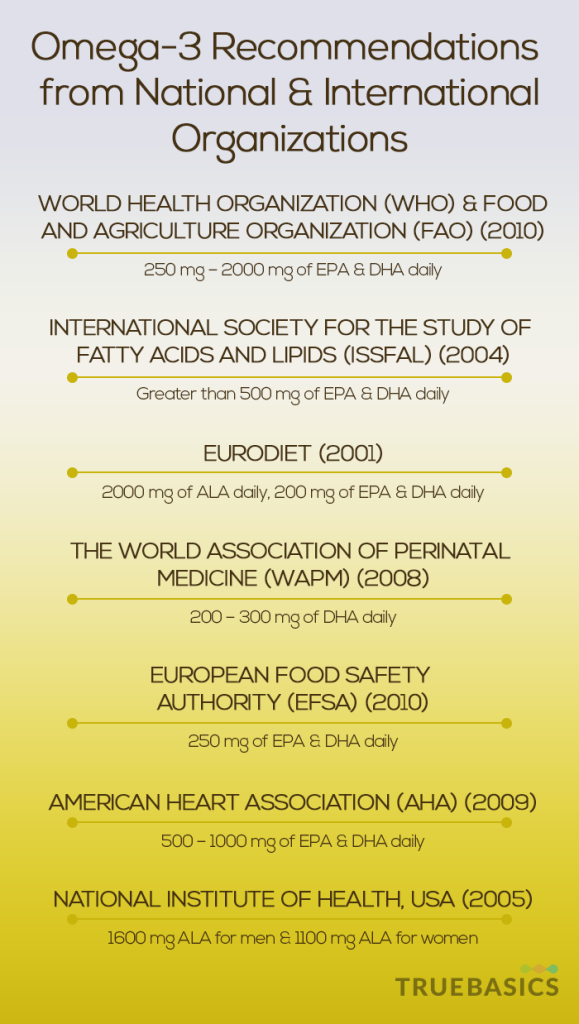Omega-3 fatty acids are polyunsaturated fatty acids. There are three main types of omega-3 fatty acids that have multiple health benefits. They are ALA (Alpha-Linolenic acid), DHA (Docosahexaenoic acid) and EPA (Eicosapentaenoic acid). They are essential fatty acids that are not produced by our body and hence need to be obtained through external diet and dietary supplements. ALA can be obtained through plant sources like walnuts, flaxseeds, soybean oil, canola oil, etc. while EPA & DHA is mainly obtained marine sources. Although some amount of ALA can be converted to EPA & DHA in our body, the conversion process is very limited with only up to 20% conversion of ALA to EPA and up to 9% for DHA.
Omega-3 fatty acids play many important roles in our body, forming structures of cell membranes and providing energy to the body. They also play a major role in decreasing inflammation, reducing the risk of heart diseases, supporting joints, improving memory, maintaining skin health, and supporting eye health.
So, how much omega-3 should you consume every day to reap the benefits of omega-3? Read on to know more
How much to consume?
Daily omega-3 requirement depends on multiple factors such as age, gender, daily diet, lifestyle, genetic, environmental factors and medical conditions. As of now, there is no specific recommended dietary allowance set for omega-3 intake. Several organizations around the world have released their recommendations but they vary widely. Also, daily EPA and DHA requirements are not charted out separately. Indian Council of Medical Research also hasn’t set any RDA values for omega-3. However, experts recommend a minimum of 1000 g of total omega-3 per day with higher requirements for certain health conditions.
The dietary recommendations of EPA and DHA vary from 250 mg – 1000 mg/day for healthy adults and 40 – 250 mg/day for children and adolescents. [1]
Below is a summary of guidelines released by key national & international organization [1] –
- World Health Organization (WHO) & Food and Agriculture Organization (FAO) (2010)
250 mg – 2000 mg of EPA & DHA daily - International Society for the Study of Fatty Acids and Lipids (ISSFAL) (2004)
Greater than 500 mg of EPA & DHA daily - Eurodiet (2001)
2000 mg of ALA daily, 200 mg of EPA & DHA daily - The World Association of Perinatal Medicine (WAPM) (2008)
200 – 300 mg of DHA daily - European Food Safety Authority (EFSA) (2010)
250 mg of EPA & DHA daily - American Heart Association (AHA) (2009)
500 – 1000 mg of EPA & DHA daily - National Institute of Health(NIH), USA (2005)
1600 mg ALA for men & 1100 mg ALA for women

For assessment of EPA and DHA levels in the tissue, the omega-3 index can be utilized which reflects EPA plus DHA content expressed as a percentage of total fatty acids. [2]
Key Point: There is a difference in total omega-3 content and EPA+DHA content in most omega-3 supplements. Any omega-3 supplement would have, apart from EPA and DHA, other omega-3 fatty acids as well. For e.g. a 1000 mg omega-3 supplement would have somewhere between 600 – 800 mg of EPA and DHA. Check the product label to find out the total omega-3 and exact EPA+DHA content.
Omega-3 Requirement in Specific Cases
1. Cardiovascular Diseases
Scientific studies have suggested that including omega-3 rich food in the diet promotes heart health and is linked with reduced CVD risk. Consumption of omega-3 helps improve blood lipids and reduce blood pressure levels.
American Heart Association (AHA) recommends a minimum of 1000 mg/day EPA + DHA dose either from food sources or fish oil supplements for patients with coronary heart diseases. Studies on the associated benefits of omega-4 with an inadequate dose of less than 1000 mg have provided inconsistent results. It is estimated that consistency in cardiovascular effects by omega-3 can be expected in dosage more than 2000 mg daily. [3]
To lower levels of triglycerides, AHA recommends a dose of 2000 – 4000 mg of EPA plus DHA daily. Considering that achieving the adequate daily requirement of 1000 mg daily in CHD patients and 2000 – 4000 mg daily in hypertriglyceridemia patients is difficult just by fish consumption, omega-3 supplements might be necessary to bridge the requirement gap. [4]
The Clinical trial REDUCE-IT (Reduction of Cardiovascular Events with EPA—Intervention Trial) published its findings in Jan 2019 and reported that an omega-3 supplementation of 4000 mg (2000 mg daily) showed significant improvement in CVD patients. [5]
A higher dose of omega-3 can help patients with cardiovascular diseases. However, such higher dosages should be initiated after proper consultation with a health practitioner.
2. Rheumatoid Arthritis
Omega-3 plays an important role in relieving joint pain and stiffness that occurs due to arthritis.
A comprehensive scientific review published in the Journal of Clinical Rheumatology in 2017included at least 20 studies that focused on the role of fish oil supplementation in rheumatoid arthritis (RA). In the studies, the amount of EPA consumed was about 200 – 4600 mg daily and DPA was consumed about 200 – 2100 mg daily for a period of 12 – 52 weeks. Ten studies reported a decrease in the tender joint count (TJC) which was the most common improved outcome in the fish oil supplementation group. Eight studies reported a decrease in early morning stiffness (EMS) duration, second most common improve outcome omega-3 supplementation. The studies also observed improved outcomes such as a decrease in the swollen joint count (SJC) and improvement in physician’s global assessment in 7 and 6 studies respectively. 5 studies also observed a reduction in the usage of non-steroidal anti-inflammatory drugs when the daily diet was supplemented with omega-3 supplements. [6]
3. Diabetes
Diabetes patients are prone to a significant risk of developing heart conditions. Type-2 diabetes is linked with hypertriglyceridemia which significantly leads to an increase in the risk of cardiovascular diseases. 5
A study published in 2018 in the journal Cardiovascular Diabetology mentioned that omega-3 fatty acid corrected postprandial hypertriglyceridemia, insulin secretion ability, and hyperglycemia. Omega 3 supplements also attenuate the progression of albuminuria in patients with type-2 diabetes and coronary artery disease. [7]
Another study published in 2016 by Han et. al. showed that omega 3 supplementation reduces albuminuria and maintains renal function in diabetic patients with hypertriglyceridemia. It was observed that the patients treated with a higher dose of 4000 mg of omega-3 fatty acids showed higher maintenance in renal function than the patients treated with lower doses. [8]
4. Neuropsychiatric Disorders
Studies have shown a strong correlation between low omega-3 status and higher severity and prevalence of varied neuropsychiatric disorders.
A 2019 study published in the journal Therapeutic Advances in Psychopharmacology explored the efficacy and safety of omega-3 fatty acids in neuropsychiatric disorders. The study reported that omega-3 supplementation showed a positive effect on neuropsychiatric disorders such as depression, schizophrenia, attention deficit hyperactivity disorder (ADHD), post-traumatic stress disorder (PTSD), Alzheimer’s disease, dementia, and cognitive function, Parkinson’s disease, and many others. [9]
Omega 3 doses between 1000 – 3500 mg have shown therapeutic effects on neuropsychiatric disorders like depression.
5. Pregnancy and Lactation
Omega-3 fatty acids play an important role in infant health and neurodevelopment. DHA is a structural component of the brain and plays a key part in the brain and retina development of the fetus. The American Academy of Pediatrics recommends about 200 – 300 mg of DHA daily for lactating women to ensure an adequate amount of DHA in breast milk. This can be obtained by consuming 1-2 servings of fatty fish per week. [10]
Dietary Guidelines for Americans, 2015-20 recommends an 8 – 12 ounces (~250 mg) of seafood every week during pregnancy and lactation. However, heavy metal contamination of fishes is a common phenomenon and therefore care must be taken in choosing fishes that are high in EPA & DHA content but low in mercury. Generally, fishes like king mackerel, shark are high in methyl mercury while salmon and sardines are low in mercury contamination. [11]
National Institute of Health (NIH) recommends an adequate intake of 1400 mg of ALA during pregnancy and 1300 mg of ALA daily during the lactation phase.
6. Cancer
Omega-3 has shown significant potential in the treatment of tumorigenesis (colon and liver tumors in particular, but also include prostate and breast cancer). However, the research is nascent and the benefits of omega-3 for cancer a matter of further research.
A 2019 study on advanced cancer patients published in the journal Nutrients reported that daily consumption of minimum 1500 mg of omega-3 for a long duration is linked with improved biological, clinical and QoL (quality of life) parameters. [12]
How Much of Omega-3 Intake is Safe?
Side effects of omega-3 supplements are mostly mild. Commonly reported ones include bad breath, unpleasant taste, nausea, heartburn, diarrhea, gastrointestinal discomfort, odoriferous sweat, and headache.
Omega-3 is generally considered safe for consumption and there is no specific limit to its consumption. Any side effect of a high dosage would manifest only if a higher dosage is continued for longer periods. However, it is advised to consult a doctor before consuming relatively higher dosages. Agencies and expert organization around the world provide their own safe limits based on researches available from multiple sources.
EFSA considers intake of DHA alone up to 1000 mg daily through supplements safe for consumption of the general population. A total daily intake of up to 5000 mg EPA plus DHA (1800 mg daily of EPA alone through supplements) is recommended as safe for adults by EFSA and does not affect immune function, lipid peroxidation, glucose homeostasis or cause bleeding problems. [13]
FDA, on the other hand, recommends a 3000 mg limit of total daily omega-3 consumption (of which not more than 2000 mg from omega-3 supplements). [14]
American Heart Association (AHA) also doesn’t recommend intake of more than 3000 mg of EPA plus DHA from supplements without a physician’s supervision even in case of hypertriglyceridemia patients. [14]
National Institute of Medicine noted that a higher amount of EPA & DHA (600 mg DHA plus 900 mg EPA or more daily for many weeks can reduce immune function due to the suppression of inflammatory responses. Also, doses of 2000 – 15000 mg daily of EPA and DHA may also increase bleeding time due to a reduction in platelet aggregation. [15]
In Conclusion…
Daily intake recommendations of omega-3 fatty acids (EPA plus DHA) vary from 250 – 1000 mg for adults and 40 – 250 mg for infants, children, and adolescents. Omega-3 fatty acids (total EPA plus DHA) with a dosage of up to 3000 mg daily can be consumed safely by a healthy population. However, it is recommended to not consume more than 2000 mg of omega-3 daily through supplements. Consult a doctor if a higher omega-3 dosage needs to be taken. Scientific studies have shown that higher doses of omega-3 fatty acids (up to about 4000 mg daily) may be effective in patients at risk of chronic diseases. EFSA, FDA, and AHA maintain a daily limit of up to 3000 – 5000 mg of omega-3 as a safe limit. But higher doses should always be taken after consulting a physician.
Also, don’t
forget to check the exact content of EPA and DHA on the product label. It’ll
mostly be different than the total omega-3 content.
Sources:
[1] https://www.ncbi.nlm.nih.gov/pmc/articles/PMC4537707/
[2] https://www.ncbi.nlm.nih.gov/pubmed/18541601
[3] https://www.ncbi.nlm.nih.gov/pmc/articles/PMC6112138/
[4] https://www.ncbi.nlm.nih.gov/pmc/articles/PMC3875260/
[5] https://www.clinicalcorrelations.org/2019/05/24/is-there-evidence-to-support-the-use-of-omega-3-fatty-acids-in-preventing-cardiovascular-events/
[6] https://journals.lww.com/jclinrheum/Fulltext/2017/09000/Omega_3_Fatty_Acids_in_Rheumatic_Diseases__A.6.aspx
[7] https://www.ncbi.nlm.nih.gov/pmc/articles/PMC4852914/
[8] https://www.ncbi.nlm.nih.gov/pubmed/27135947
[9] https://www.ncbi.nlm.nih.gov/pmc/articles/PMC6591664/
[10] https://ods.od.nih.gov/factsheets/Omega3FattyAcids-HealthProfessional/
[11] https://www.fda.gov/food/consumers/advice-about-eating-fish
[12] https://www.ncbi.nlm.nih.gov/pmc/articles/PMC6566772/
[13] https://efsa.onlinelibrary.wiley.com/doi/abs/10.2903/j.efsa.2012.2815
[14] https://www.ncbi.nlm.nih.gov/pmc/articles/PMC3875260/
[15] Institute of Medicine, Food and Nutrition Board. Dietary reference intakes for energy, carbohydrate, fiber, fat, fatty acids, cholesterol, protein, and amino acids (macronutrients). Washington, DC: National Academy Press; 2005.













